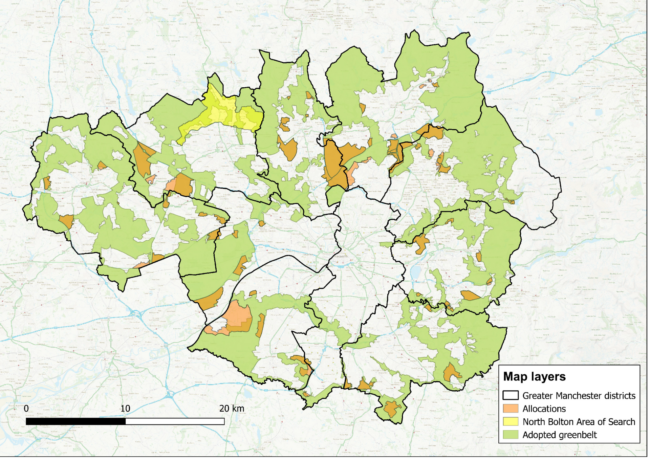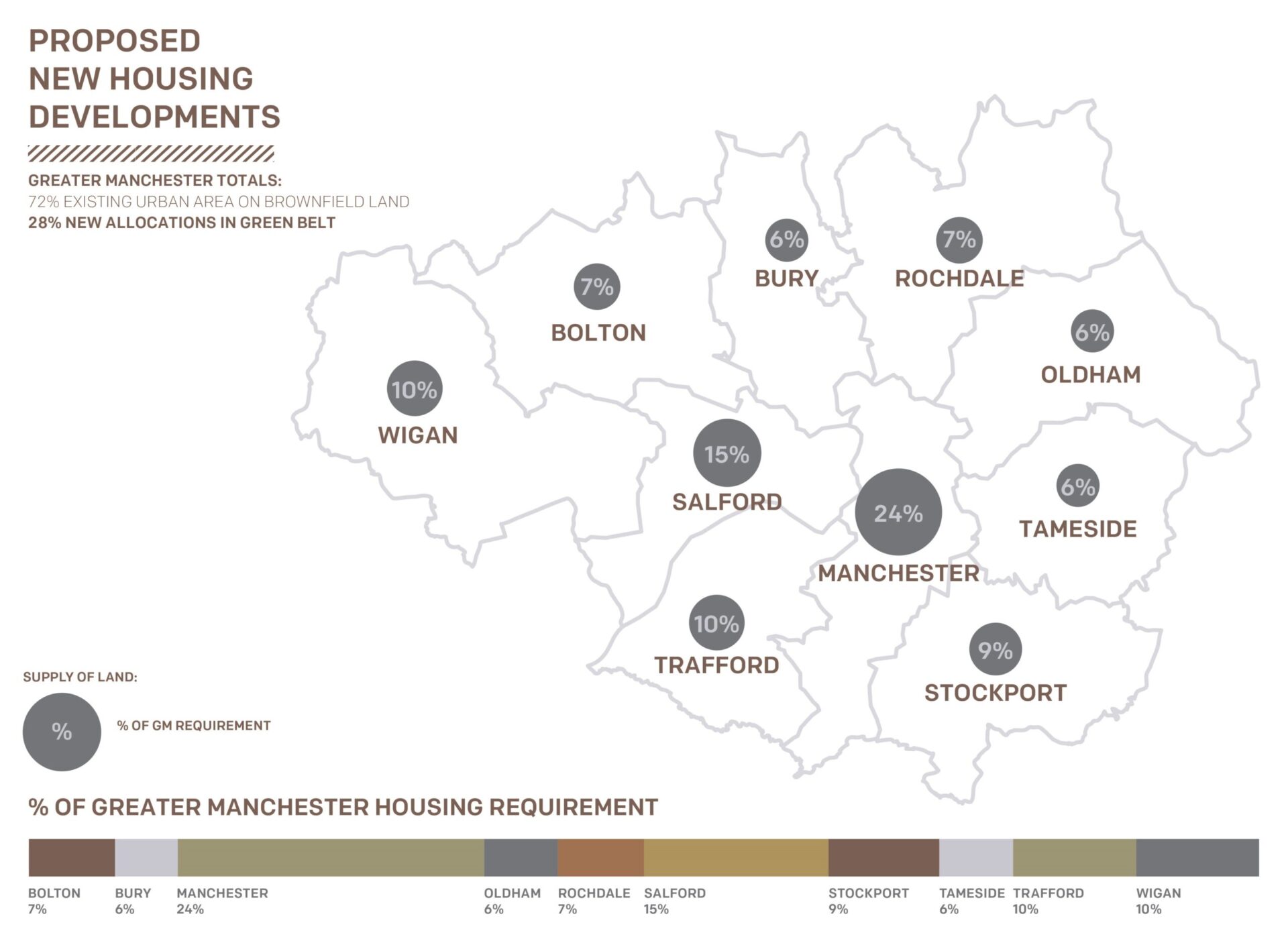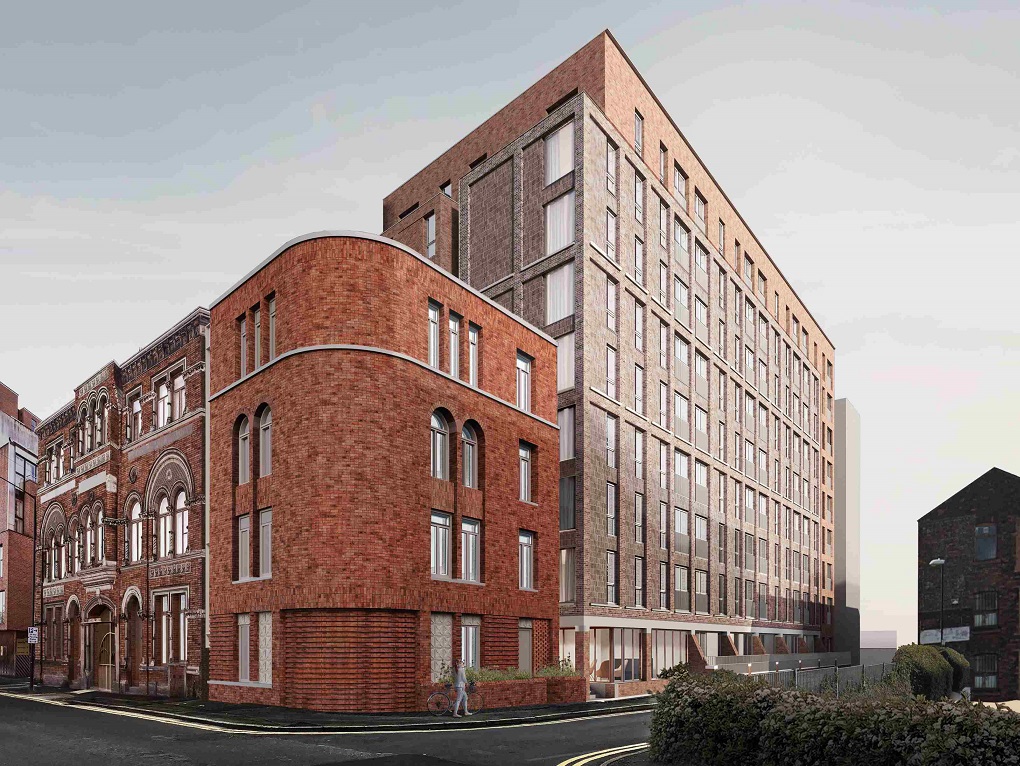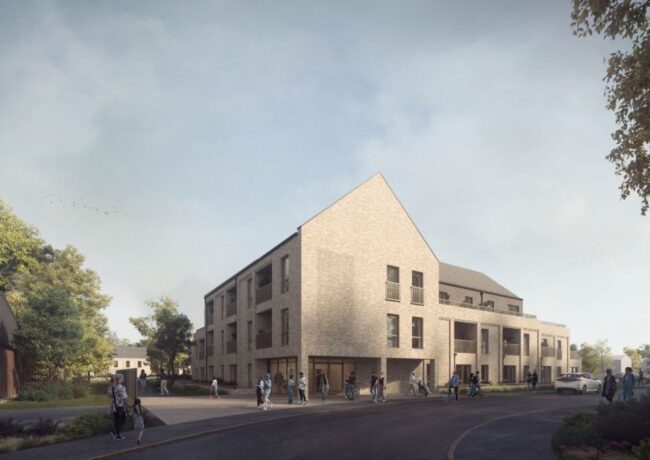Green Belt release ‘essential’ to hit GMSF growth targets
More than 60,000 homes will be built on Green Belt in Greater Manchester in the next 20 years, concentrated on a “few large sites”, according to the long-awaited spatial framework for the city region, published overnight.
The draft report is the first time a statutory planning blueprint has been produced for all 10 local authorities in the city region. The plan is expected to be adopted in 2018, subject to further consultation in 2017 and a final vote by council leaders and the new city region mayor. The draft strategy will go to the Greater Manchester Combined Authority executive next Friday before eight weeks of consultation begin.
The 225-page paper lists the sites chosen to deliver:
- 227,200 new homes
- 26.3m sq ft of office space, 55% within the city centre
- 87.3m sq ft of industrial space
The report says the release of Green Belt is “essential” to deliver the housing needed to keep up with the city region’s growth. The bulk of new housing allocation will be on brownfield sites, with a town and city centre first approach. However, 28% will be on Green Belt, equating to 63,616 homes on land previously protected from development by 2035.
In all, 4,887 hectares or 12,076 acres, equal to 8.2% of Green Belt, would be lost, which is 3.8% of Greater Manchester’s total area.
Bury is the hardest hit, taking 20% of Green Belt out of protection, followed by 11% in Trafford.
The areas of Green Belt that would come into play for developers after the boundary review include:
- Davenport Green, Airport City, capable of delivering 3,300 homes and 5m sq ft of offices
- Carrington, 11,500 homes, retaining Green Belt gap between Carrington, Partington and Sale West
- Airport City South for logistics
- Roundthorn Medipark extension for commercial space
- Cleworth Hall, Tyldesley, Wigan, 400 homes
- Hulton Park and Chequerbent, 2,700 homes
- Extension of Port Salford, 4m sq ft of industrial space, compensated by improvements to Chat Moss nature reserve
- Godley Green, south east of Hyde, new ‘garden village’ of 2,350 homes
- Land at Flixton Station for 750 homes
- Littlemoss, Ashton, 2,000 homes and 2m sq ft of commercial
- Land off A34 and Bradshaw Hall Lane, Stockport, 3,700 homes
- Extension of Kingsway Business Park south of J21 M62, to deliver 4.8m sq ft and 1,500 homes
- Land north of J19 M62 and M66 at Heywood for 1,000 homes and 17m sq ft of business space, possibly with rail freight spur
- Whitefield, 600 homes
- 450 acres at Junction 6 of the M61, for 4.7m sq ft of logistics
- South of M62 east of Prestwich, around Simister and Bowlee, for 3,400 homes
- Astley and Boothstown, 1,000 homes
- Walshaw, Bury, 1,250 homes
- M6 Junction 25, southern edge of Wigan, 3.5m sq ft logistics
- Western Cadishead and Irlam, 2,250 homes
- Land east and west of A627M next to Stakehill Business Park, Middleton
- North of Mosley Common, Wigan, 1,000 homes
- South Pennington next to A580 East Lancs Road, 1,000 homes
- West of Gibfield, Atherton, 750 homes and 500,000 sq ft logistics space
- Broadbent Moss, Oldham, 1,000 homes and 500,000 sq ft employment space
- West of Westhoughton, 2,000 homes
- Beal Valley, Oldham, 900 homes
- East Boothstown, Salford, next to RHS Garden Bridgewater site
- Woodford, Stockport, 2,400 homes
- High Lane, Stockport, 4,000 units
- Heald Green, Stockport, 2,000 units
- Sidebottom Fold, Tameside, 650 homes outside Stalybridge
- Land at Elton Reservoir, Bury, 3,460 homes
- New Springs, Wigan, 1,050 homes
After the review, 43% of Greater Manchester will remain in Green Belt. Three areas will be added to Green Belt: listed as West Salford Greenway, Rectory Lane, Standish in Wigan, and land within the Roch Valley in Rochdale.
The GMSF also paves the way for Mayoral Development Corporations to be created to help deliver key sites. An Infrastructure Delivery Plan is also due to be published setting out how utilities and other services will be provided.
The economic growth forecasts chosen by the councils identifies the need for an additional 227,200 new homes across Greater Manchester by 2035. The boroughs will share the additional housing as follows:
- Bolton 7%
- Bury 6%
- Manchester 24%
- Oldham 6%
- Rochdale 7%
- Salford 15%
- Stockport 9%
- Tameside 6%
- Trafford 10%
- Wigan 10%
Alongside housing, logistics is another priority in the plan. The rate of delivery of logistics space proposed would be 40% greater than the average developed since 2004.
A spokesman for GMCA said: “A key consideration of the development of the framework has been to adopt a brownfield first approach to land allocation. This focus has ensured that nearly three quarters of the proposed land supply is within the existing urban area on brownfield land with remaining new allocations from land being withdrawn from the greenbelt. A new greenbelt boundary for Greater Manchester will offer greater protection to prevent development in the newly designated greenbelt whilst also meeting our housing and employment needs over the next 20 years.
“Greater Manchester’s greenbelt was designated 30 years ago to check unplanned development and whilst it is still relevant for that purpose the time has come to revise the boundary to ensure space for growth over the next 20 years.”
The plan focuses on “relatively few, large sites” within the Green Belt, often close to a motorway junction or other transport infrastructure. Additional roads and Metrolink stations will be needed to unlock the allocated land and this will be funded partly by developers.
The spokesman added: “The future Greater Manchester Mayor, alongside GMCA will be able to apply new powers secured from the Government, to ensure that developers make a fair and reasonable contribution towards the infrastructure need that they generate through the development of sites.”
Many in the region’s property industry fear the plan is overly cautious and does not go far enough. Dan Mitchell, partner at planning adviser Barton Wilmore in Manchester, explained: “We welcome the publication of the Draft GMSF and look forward to reviewing the detail. The Committee report rightly notes that Greater Manchester is starting to show real and sustained growth in jobs and population. However, it still performs below the national average in terms of productivity and growth with weak economic performance in many areas. GMSF needs to be ambitious in its approach to development if it is to help drive the Northern Powerhouse agenda. Early indications are that developers and housebuilders have considerable reservations about the 20-year plan and whether the 200,000 jobs to be created and 225,000 homes, across the UK’s second city and spread amongst 10 local authority areas, really does go far enough.”
Gary Halman, partner at HOW Planning, added: “The approach involves focusing Green Belt release on on a small number of large sites, rather than piecemeal release around the edges in individual districts. This strategy isn’t without risk; for example, large scale strategic release allocations involve very long lead-in times and demand massive investment in supporting infrastructure- which the plan acknowledges. Delivering this infrastructure in a timely way will be critical to securing the boost in housing supply which the plan is looking to achieve.”
Cllr Richard Farnell, leader of Rochdale Council and lead member for planning and housing at GMCA, said: “Greater Manchester is a thriving city region, renowned across the world for its numerous technological and scientific advancements, and sporting and artistic excellence. We support a culture of innovation and enterprise.
“In order to continue to attract business, workers and tourists, we need to grow. We will successfully manage this growth and deliver major economic, social and environmental improvements. We are mindful that this needs to support Greater Manchester’s prosperity in the long term as well as meet its short-term needs.
“We want all residents of Greater Manchester to share in the benefits of this prosperity.”
The draft GMSF can be access through the combined authority agenda paper for next week’s executive meeting here: https://www.greatermanchester-ca.gov.uk/meetings/meeting/326/joint_gmcaagma_executive_board







“Many in the region’s property industry fear the plan is overly cautious and does not go far enough.”
i.e release more land in high value areas so our clients can build more 4 and 5 bedroom houses and pretend they are doing their bit to help housing affordability.
By Nordyne
I think the approach makes sense the greenbelt release is long overdue. Lets get it approved and move on.
By All-for-it
flooding !!!!!
By Anonymous
Bet the councillors don’t live in the areas where they are proposing so much housing, too many houses packed in together but what do they care at the end of the day for every house its more council tax but less services. Disgusted!!!!!
By Graham
Houses…yes…BUT. Those being built are not for first time buyers on lower incomes…The REAL people who need help
By Anonymous
You’ll all get the chance to have your say, raise objections, complaints, etc on your respective local authority Green Belt “release” proposals. Let’s hope you use it wisely.
By Mizzer
Hands off our greenbelt! We don’t need more congestion and pollution in Greater Manchester. Perhaps it’s time to get out of this ever expanding cesspit!
By Nothappy
If they built “affordable housing” instead of Luxury housing then there would be more justification….but they aren’t.
All this is is an exercise to line peoples pockets.
IF more houses are genuinely needed then why not build them where houses have already been demolished thus keeping the greenbelt? It isn’t rocker science.
I bet non of the Councillors, MPs etc live near these so called “garden villages”.
Garden Villages? More like Garden cities.
Absolutely fuming and disgusted.
By FUming
[…] on the GMSF has been ongoing since 2014. A first draft was published in October and recommended 227,200 new homes be built in the next 20 years, 28% of the new units on Green Belt […]
By Andy Burnham redrafts the GMSF | Save Tameside Green Belt
SAY NO TO BUILDING ON THE GREENBELT. WE DON’T NEED MORE PEOPLE, MORE HOUSES AND MORE CONGESTION AND WE ALL KNOW THE REAL REASONS ARE TO MAKE THE RICH RICHER, NOT TO HOUSE THE POOR AND THE HOMELESS.
By Nothappy